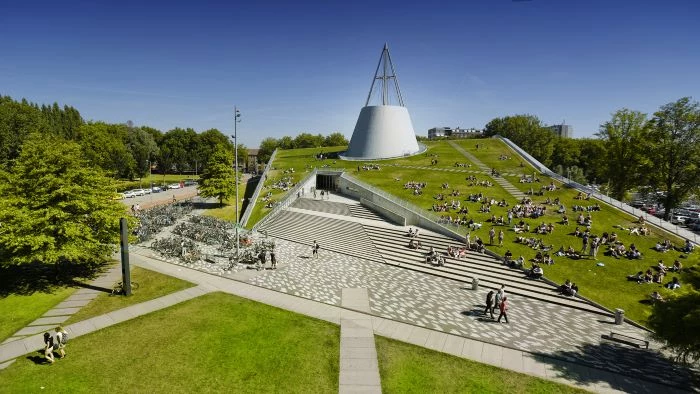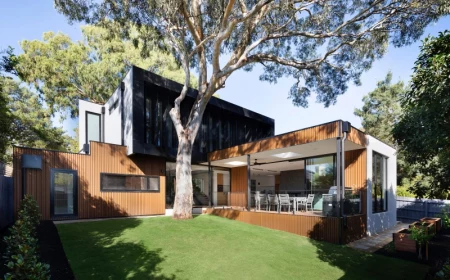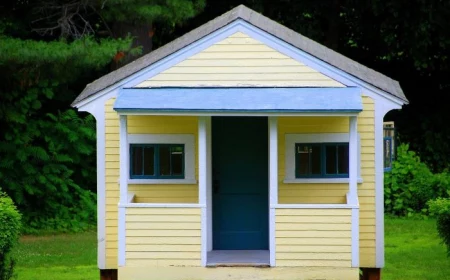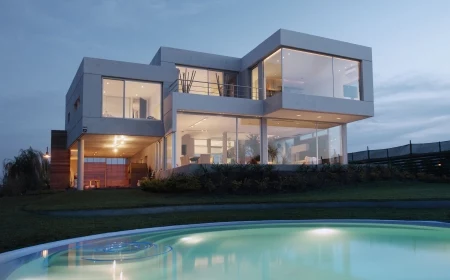Forget the Rankings: How to *Actually* Choose an Architecture School
I’ve been in this field for a long time. I’ve seen fresh-faced students turn into licensed pros, and honestly, I’ve hired a good number of them. The one question that always comes up is, “So, where should I go to school?” It’s usually followed by a list of universities they pulled from some fancy magazine.
In this article
My answer is always the same. Rankings are a starting point, sure, but they miss the most important part: they don’t tell you how a school will teach you to think.
Here’s the deal: picking an architecture school isn’t like choosing a business or law program. You’re not just downloading a bunch of facts. You’re fundamentally shaping your creative voice and learning a whole new language of space, form, and material that will stick with you forever. The philosophy of a school—its core belief about what architecture even is—is so much more important than its rank. Some schools will train you to build with breathtaking precision. Others will teach you to question the very purpose of a building. Neither is wrong, but one is probably a much better fit for you.

I can often tell where a young architect studied just by looking at their portfolio. I see it in how they tackle a problem, the kinds of questions they ask, and the way their drawings tell a story. This guide is built on that experience. We’re going to look past the lists and get into the real philosophies that drive architecture programs. This is about finding the right launchpad for the architect you want to become.
First Things First: What’s the School’s Vibe?
Before you even glance at a school’s name, you need to understand the main currents in architectural education. Most schools are a blend, but they almost always lean in one direction. Figuring out that lean is your first step. Think of it as learning the science behind the art, which makes the practical choices way easier.
1. The Technical School: The Master Builders
These schools are all about the ‘how.’ Their whole philosophy is that incredible design grows from a deep, almost obsessive, understanding of materials, structure, and construction. Think of them as the spiritual descendants of the Bauhaus tradition, which was all about merging art with craft.

Students here live in the workshop and the computer lab. They learn about tectonics—the art and science of how things join together. When I see a portfolio from one of these grads, the details are just beautiful. The wall sections are drawn with unbelievable precision. They can tell you exactly why a steel beam is a certain depth or how to design a connection that won’t leak heat. Their physical models aren’t just foam core concepts; they’re stunning pieces made from real wood, metal, and concrete.
What you’ll learn: Material science, structural principles, building codes, digital fabrication (like CNC milling and 3D printing), and the nitty-gritty of construction documents.
Who it’s for: If you love taking things apart, find beauty in a perfectly made joint, or believe an architect’s first job is to build things that last, this is your jam.
Research Tip: How do you spot one of these schools online? Sift through their course catalog and website for keywords like “fabrication lab,” “tectonics,” “building systems,” “materials research,” and “integrated design.”

2. The Theoretical School: The Big Thinkers
These schools are driven by the ‘why.’ They see architecture as a cultural act, tangled up in history, philosophy, and social issues. A studio project here might not even be a normal building. You could be asked to design a library for a society without books, or a memorial to an abstract idea like ‘forgetting.’
It can seem a little out there, but the goal is to forge powerful critical thinking skills. Graduates learn to read a city like a book and see the hidden political and social forces at play. Honestly, their final reviews can feel more like a PhD defense than a building presentation, with more writing and debate than technical drawings. Their portfolios are full of wild diagrams, manifestos, and deep research. They’re taught to shape the conversation about architecture, not just the concrete and glass.
What you’ll learn: Architectural history and theory, critical analysis, urban studies, philosophy, and advanced research methods. You’ll learn to write, debate, and defend your ideas with serious intellectual muscle.

Who it’s for: If you’re fascinated by big ideas, love to read and write, and think architecture can change society, you’ll thrive here.
Research Tip: To find these programs, look for phrases like “critical theory,” “discourse,” “speculative design,” and “architectural humanities.” Check out the faculty, too—do they publish more books or build more buildings? That’s a huge clue.
3. The Design-Build Program: The Hands-On Makers
This approach takes the technical school’s love for ‘making’ and puts it directly into practice. Often, the heart of the curriculum is a project where students design and then physically build something, usually for a community that needs it. There are famous examples of this, but many schools now offer similar programs.
I once worked with an architect who came from a design-build program, and she had a totally different feel for materials. She knew the real weight of a concrete block because she’d laid them all day. She understood the tolerances for a wood connection because she’d cut it with her own hands. There’s a practical wisdom that comes from that experience. You learn fast that a line on a screen has real-world consequences in time, money, and sweat.

What you’ll learn: Real-world construction skills, project management, client communication, and how to be resourceful. Learning to design with a tight budget and whatever materials are on hand is one of the most valuable skills you can have.
Who it’s for: If you learn by doing, want to see your work make a direct impact, and aren’t afraid to get your hands dirty, look for a school with a strong design-build option.
Research Tip: Search for “design-build,” “community design center,” or “hands-on building project.” Look for photos of students on a construction site, not just in a studio.
A Quick Breakdown: Which Path is Which?
So you don’t get lost, think of it this way. It’s not a perfect system, but it helps clarify what you’re looking for:
- The Technical School asks:“How can we build this flawlessly?” Their graduates are masters of detail. Your portfolio needs to show precision and a love for how things go together.
- The Theoretical School asks:“Why should we build this at all?” These folks are the big thinkers and critics. Your portfolio should be packed with research, diagrams, and bold, challenging ideas.
- The Design-Build Program asks:“How can we build this with our own hands, for our community?” They are the practical makers. Your portfolio should prove you’re not afraid to get dirty and have some hands-on experience, even if it’s just from a summer job.

A Look at Well-Known Programs (and What They Really Mean for You)
Let’s talk about some of the programs you’ll see on those “top ten” lists. This isn’t a ranking. It’s a character sketch based on what the industry knows about their graduates. Remember, schools are always evolving, so do your own digging!
An Elite US Tech Institute:
This kind of place is where architecture meets science and bleeding-edge tech. Being part of a world-class technology university defines its culture. The focus is heavy on computation, developing new materials, and sustainable systems. The work is often super experimental. A desk crit might be about algorithms as much as aesthetics. Expect an intense, interdisciplinary vibe where you’re encouraged to take classes at their famous media lab or with engineering departments. Heads up, this comes with a top-tier price tag. You’ll be looking at tuition in the $50,000-$60,000 per year range, so a huge part of your process will be hunting for scholarships and aid.

A Wildly Experimental London School:
Known for being one of the most avant-garde schools on the planet, this place is all about pushing boundaries. It often runs on a “unit” system, where you work with a specific tutor on a theme for the whole year—themes that can border on science fiction. The focus is on speculation, storytelling, and creating mind-blowing visuals. It’s not the place to learn how to detail a window flashing; it’s the place to ask if buildings even need windows. Some pros gripe that grads lack practical skills, but firms hire them for their fearless creativity. Just remember to factor in London’s sky-high cost of living on top of international tuition fees.
A Major Dutch Technical University:
A powerhouse of European education, this type of school is rooted in pragmatism. There’s a huge emphasis on urbanism, landscape, and housing—all critical issues in a dense country. The approach is rigorous, research-based, and deeply connected to engineering. Grads are known for being excellent all-rounders, great at both large-scale urban strategy and detailed design. A quick but crucial note for undergrads: many bachelor’s programs in continental Europe are taught in the local language (like Dutch or German), even if the master’s programs are in English. Always check this!

A Prestigious Swiss Institute:
This is where deep, intellectual theory meets legendary Swiss precision. It’s a place that produces thinkers who can also build, masterfully. The influence of modernism is strong, with a focus on rational design, minimal aesthetics, and a masterful use of materials like concrete and wood. The programs are incredibly demanding. Faculty are often international stars who are also actively practicing. Like other European public universities, tuition can be significantly lower than in the US, but language proficiency is often a must for undergraduate studies.
The Real-World Stuff No Brochure Will Tell You
Okay, let’s get down to the brass tacks. Choosing a school is also a practical, life-altering decision. This is the advice I give everyone.
Your Portfolio is Your Golden Ticket
Grades matter, but your portfolio is what gets you in the door. It is the single most important part of your application. Do not—I repeat, do not—just cram every project you’ve ever done into it. Curate it. Show your process, not just the glossy final picture.

Lesser-known trick: Dedicate a full page to a single project’s evolution. Title it something like “The Life of an Idea.” Show the messy napkin sketch, a photo of a rough basswood model with glue all over it, and then the final rendering. That tells a much better story than ten perfect, lifeless images. It shows you can think, experiment, and grow an idea.
Investigate the Studio Culture Like a Detective
You will spend more time with your studio mates than with almost anyone else. Studio is where the real learning happens—in those late-night work sessions (we call them ‘charettes’) and the informal critiques you get from your peers. A healthy studio culture is more valuable than a famous professor you see once a week.
Here’s how you find out the truth: Don’t be shy. Find the school’s architecture student group on Instagram (search for things like #[UniversityName]Arch) and send a direct message to a couple of students. Ask them one simple question: “What’s the vibe like during finals week—collaborative or every person for themself?” Their answer will tell you everything you need to know.
From my experience, I once hired two junior architects at the same time. One was from a world-famous, high-pressure school and had a stunning portfolio. The other was from a solid state school I’d barely heard of. The first one was brilliant but couldn’t take criticism and struggled to work with a team. The second one was the ultimate team player, always asking for feedback and lifting everyone up. Guess who became invaluable to our firm? It wasn’t the one with the famous diploma.
Your Non-Negotiable Pre-Decision Checklist
Let’s be real: architecture school is brutally expensive, and starting salaries aren’t like in finance or tech. You have to be realistic about debt. Before you say yes to any school, run through this list:
- Is the program professionally accredited? This is the most important question. For a straightforward path to getting licensed in the US, the program MUST be accredited by the National Architectural Accrediting Board (NAAB). In the UK, it’s the Royal Institute of British Architects (RIBA). Other countries have their own boards. Graduating from a non-accredited program can add years and thousands of dollars to your journey. Find the official accreditation websites and verify the school’s status. This is non-negotiable.
- What’s the real cost? Don’t just look at the sticker price. For US schools, find the university’s “Net Price Calculator” online. It gives you a much better estimate of what you’ll actually pay after grants and scholarships.
- Have I talked to a current student? I’m serious. Go back to that Instagram tip. One honest conversation is worth more than a dozen slick brochures.
A Quick Word on Mental Health
The industry is finally starting to talk about this, and it’s about time. Architecture school is a pressure cooker. The all-nighters, the intense public criticism of your creative work (which can feel deeply personal), and the sheer workload can lead to serious burnout. A good school knows this and has resources to support student well-being. Look for a program that fosters a culture of support, not just brutal competition. Your health is the foundation of your career.
So, What’s the Takeaway?
I’ve worked with brilliant architects from famous, expensive schools and equally brilliant ones from lesser-known state universities. The school just opens the first door. You have to be the one to walk through it, and every single door that comes after.
So, forget finding the “best” school. Find the right school for you. Be brutally honest with yourself. Are you a maker, a thinker, or a storyteller? Do you want to learn how to build beautifully, or do you want to challenge why we build at all? Read the course descriptions. Stalk the student work online. Research the faculty and see what they’re actually doing—are they building, writing, or inventing?
The goal is to graduate not just with a stack of projects, but with a unique way of seeing the world. That’s the real foundation of an architectural education. It’s what will carry you through the long nights of school and the even longer, more rewarding years of practice. Choose the place that will build that foundation inside of you.










